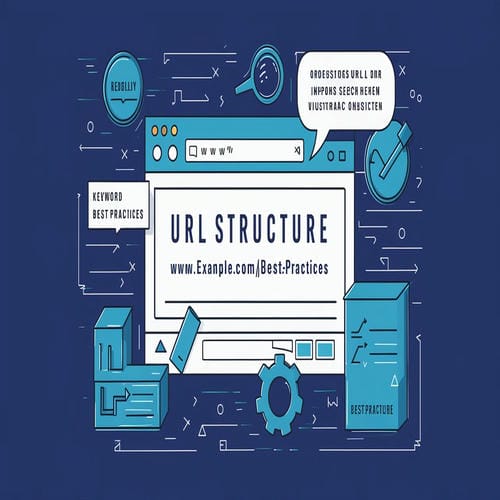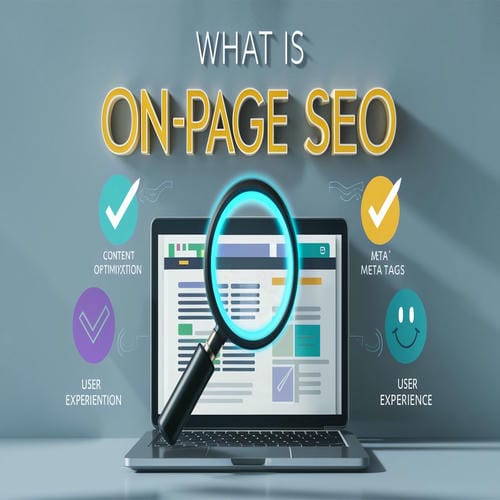ON-Page SEO Tips by Devtrain
Have you ever found yourself lost on search engine results, wondering how some websites consistently appear at the top?
Enter on-page SEO—the cornerstone of digital visibility and organic search success. In a world where every click matters, understanding how to optimize your web pages for search engines can make all the difference.
On-page SEO, often referred to as on-site SEO, revolves around optimizing individual web pages to rank higher and earn more relevant traffic in search engines. It’s not just about stuffing keywords anymore; it’s about crafting user-centric content, refining technical elements, and mastering the art of click-worthy titles and descriptions.
In this comprehensive guide, we’ll delve into the essential elements of on-page SEO, explore advanced tactics to boost your rankings, and equip you with practical strategies to stay ahead of the competition.
Get ready to unlock the secrets of effective on-page SEO and transform your online presence. Let’s dive in!
What is ON-Page SEO?
In the present digital marketing network, on-page SEO can be considered as one of the most important processes that have the potential to improve your website’s visibility and its ranking in the organic section of search engine result pages. This technique entails fine-tuning different aspects which are embedded within HTML codes of your web pages to conform to search engine algorithms as well as users’ intention.
- Definition and Scope of On-Page SEO: On-page SEO refers to the practices that can be applied on site’s content, HTML source code and internal linking structure to enhance its position on SERP. Some of the areas that fall under technical SEO include keywords optimization, meta preceding tags, URL framework, and internal linking among others.
- Differentiation from Off-Page and Technical SEO: Distinction from Other SEO Types Whereas off-page SEO focuses on signals outside the website such as backlinks and social shares and technical SEO that concerns the site’s crawlability and speed, on-page SEO focuses on content relevancy and visitor experience that is evident from the webpage level.
- Significance in Digital Marketing: On-Page SEO optimizes website not just for search engines but also for user experience and Click-through rate. This serves to assure that not only has your content been discovered by search engine systems but that this content is also relevant and meaningful to your target consumer.
It is essential to get acquainted with these basics to design a long-lasting on-page SEO strategy successfully delivering organic traffic to your website.
Must Read:
- What is White Hat SEO (Search Engine Optimization)?
- What is SEO in Digital Marketing?
- What is SEO Writing?
- What is Local Search Engine Optimization?
Key Elements of On-Page SEO
A brief awareness of the various aspects of on-page SEO is vital in ensuring website optimization and enhancing the site’s presence on search engines.
Content Optimization: On-Page SEO Tactics Content is the core of on-page SEO. It comprises producing good and appropriate content that meets users’ search requirements. As you need to discover a list of terms people type into search engines and employ them throughout the content, significant for keyword research is the use of key terms in headings and subheadings, meta tags, and paragraphs.

Meta Tags and Descriptions: Meta tags refer to titles and descriptions that are short synthesizes of your web page’s content. Maximizing these tags with proper keywords and attractive strings not only helps to improve the ranking in the search engine but also increases the probability of obtaining a clickthrough.

URL Structure: A precise and meaningful URL structure is beneficial for both, the SEO point of view as well as for the viewers. Optimized URLs should contain keywords, should not be very lengthy, and should also be very much relative and readable. This is important to both search engines and users as they get to know what the page contains even before they are led there by the search engine.

Internal Linking: Internal linking covers, the act of linking within the website. This increases usability because it helps in organizing the site structure, spreading the page’s power and importance, as well as making the users open more of the content offered. Internal linking has also been found useful in enhancing every search engine’s ability to understand the architecture of most websites in addition to directing priority to specific pages.

Importance in Driving Organic Traffic: Relevance in Increasing Organic Traffic Overall, these on-page elements provide a cumulative way of enhancing your website rankings in the SERPS and increasing organic traffic. In managing these factors, you improve your site’s search engine ranking while at the same time making it much more useful and usable to the target audience, thus increasing their use and conversions.

It is critical to understand these three elements of on-page optimization as the basic foundation for lasting organic growth and to compete effectively in today’s online environment.
Must Read:
- How We Can Learn Search Engine Optimization?
- How to Optimize Website for Google Search Engine?
- Is Search Engine Optimization Worth it?
- How to Learn Search Engine Optimization?
On-Page Technical Optimization
Mastering the technical aspects of on-page SEO is crucial for ensuring your website is not only visible but also accessible and user-friendly.
- Site Speed and Performance: Site speed directly impacts user experience and search engine rankings. Optimizing images, leveraging browser caching, and minimizing server response times are essential techniques to improve loading times. Tools like Google PageSpeed Insights can help identify and rectify performance bottlenecks.
- Mobile Friendliness: With mobile devices driving a significant portion of web traffic, ensuring your website is responsive and mobile-friendly is imperative. Adopting responsive design principles and optimizing content for smaller screens enhances user experience and satisfies search engine algorithms favoring mobile-first indexing.
- Schema Markup: Schema markup enhances the way search engines interpret and display your content in SERPs. Implementing structured data for reviews, events, FAQs, and other content types can improve visibility through rich snippets and enhanced search features. Tools like Google’s Structured Data Testing Tool assist in validating schema implementation.
- Impact on Search Visibility: Technical optimization not only improves user experience but also enhances search engine visibility. Websites that load quickly, adapt seamlessly across devices, and use structured data effectively are more likely to rank higher in search results. By prioritizing these technical aspects, businesses can stay competitive and attract targeted organic traffic effectively.
Understanding and implementing these technical optimizations are essential for maximizing the effectiveness of your on-page SEO strategy and maintaining a competitive edge in the digital marketplace.
Related Articles:
- How to Earn Money by Search Engine Optimization?
- How to Become a Search Engine Optimization Specialist?
- How Does Search Engine Optimization Work?
- How to use Search Engine Optimization?
User Experience (UX) and On-Page SEO
The user environment is a major concern in customer retention and plays a crucial role in enhancing the overall performance of your SEO strategies.
- Readability and Accessibility: The factors that help to make content easily readable improve the level of users’ engagement and the results they get. Minimize the use of tread and simple language, and organize the content into sub-topics with headings and lists. Usability concerns such as descriptive alt text for images and link texts become enhanced for all because of Accessibility concerns.
- Effective Use of Multimedia: The Use of icons and buttons that lead to videos or draining information consequently increases site interest and time. A simple way to encourage visitors to stick around and not bounce off is through the use of a quiz or a rate calculator. These elements not only improve the usability of the page but also bear information for the search engine concerning the quality of the page.
- Impact on Engagement Metrics: The pages that respond well to the user will most likely have a lower bounce rate, longer time spent on the site, and higher click-through rate (CTR). Such figures help convey the signals to the search engine as to the relevance and reliability of the webpage.
- Integration with On-Page SEO: It can be seen that detailing UX with on-page SEO results in a positive merging that enhances the experiences for both users and search engines. When users’ needs are with regards to aspects such as speed, navigation, and valuable content then one enhances the usability parameters of the site as well as the possibility of an improved ranking.
User-friendly isn’t only about compliance with technical standards, it also involves providing the environment that the users are willing to dig into. Apart from UX, which forms the basis of brand building, along with other traditional SEO perspectives, one can create a long-term relationship with the audience.
Trending Articles:
- How to Optimize a WordPress site for Search Engines?
- How to Optimize Blog for Search Engines?
- How to Improve Search Engine Optimization?
On-Page SEO Best Practices
Implementing best practices is essential for maximizing the impact of your on-page SEO efforts and achieving sustainable organic growth.
- Regular Content Updates: Frequent updates signal to search engines that your website is active and relevant. Refreshing existing content with new information, insights, or media keeps it valuable to both users and search algorithms. Monitoring industry trends and audience interests helps maintain content relevance over time.
- Monitoring and Analytics: Utilizing analytics tools, such as Google Analytics and Search Console, provides valuable insights into on-page SEO performance. Key metrics to monitor include organic traffic, bounce rates, and conversion rates. Analyzing these metrics helps identify areas for improvement and measure the effectiveness of SEO strategies.
- Adapting to Algorithm Changes: Search engine algorithms evolve continuously. Staying informed about updates and adapting your on-page SEO practices accordingly ensures your website remains competitive. Engaging with reputable SEO resources and participating in industry forums can provide insights into best practices and algorithm changes.
- User Intent Optimization: Understanding user search intent is crucial for crafting relevant and targeted content. Align your on-page SEO strategy with the needs and expectations of your audience. Conduct keyword research to identify intent-driven keywords and create content that fulfills those intents effectively.
- Continuous Improvement: On-page SEO is an iterative process. Regularly audit your website for technical issues, update content based on performance data, and refine optimization strategies. By prioritizing ongoing improvement and adaptation, you can maintain and enhance your website’s visibility and effectiveness in search engine results.
By implementing these best practices, businesses can establish a solid foundation for on-page SEO success, driving organic traffic and achieving long-term digital marketing objectives.
Why Is On-Page SEO Important?
Understanding the significance of on-page SEO is crucial for maximizing your website’s visibility and attracting targeted organic traffic.
- Enhanced Search Engine Visibility: Effective on-page SEO practices improve your website’s ranking in search engine results pages (SERPs). By optimizing content, meta tags, and technical elements, you increase the likelihood of appearing prominently for relevant search queries.
- Improved User Experience: Optimized on-page elements contribute to a seamless user experience. Clear navigation, fast loading times, and relevant content satisfy user expectations and encourage longer site visits. This positive experience not only reduces bounce rates but also increases the likelihood of conversions.
- Competitive Advantage: In a competitive digital landscape, strong on-page SEO sets your website apart. By consistently delivering valuable content and optimizing technical aspects, you establish authority in your industry and attract more qualified leads.
- Long-Term Sustainability: Investing in on-page SEO builds a sustainable foundation for organic traffic growth. Unlike paid advertising, which stops generating traffic once the budget runs out, well-executed SEO strategies continue to drive results over time.
Advanced On-Page SEO Tactics
Mastering advanced on-page SEO tactics goes beyond the basics, allowing you to elevate your website’s visibility and competitiveness in search engine rankings.
- Semantic SEO Strategies: Semantic SEO focuses on understanding the intent behind search queries and providing content that comprehensively covers related topics. Incorporating natural language processing (NLP) and leveraging semantic markup (schema.org) enhances content relevance and context for search engines.
- Content Clustering and Topic Authority: Content clustering involves organizing related content into cohesive groups or clusters. By interlinking related pages and establishing a pillar-cluster model, you strengthen topical authority and signal to search engines the breadth and depth of your expertise on specific subjects.
- Advanced Keyword Optimization: Moving beyond basic keyword placement, advanced optimization techniques include using long-tail keywords, latent semantic indexing (LSI) keywords, and optimizing for voice search queries. This approach ensures your content aligns with diverse search behaviors and improves visibility across different search contexts.
- Structured Data Implementation: Implementing structured data markup, such as schema.org, enhances search engine understanding of your content. This can result in rich snippets, knowledge panels, and other enhanced search features, increasing visibility and click-through rates (CTR).
- Technical SEO Integration: Integrating advanced technical SEO practices, such as optimizing for Core Web Vitals, enhancing mobile usability, and implementing accelerated mobile pages (AMP), further enhances user experience and search engine rankings.
- Continuous Testing and Optimization: A/B testing of titles, meta descriptions, and on-page elements helps identify optimal configurations that improve CTR and user engagement. Regular audits and adjustments based on performance data ensure ongoing optimization and competitiveness in search rankings.
Optimize for Click-Through Rate (CTR)
Optimizing your on-page elements for click-through rate (CTR) is crucial for maximizing the effectiveness of your SEO efforts and increasing organic traffic.
- Importance of CTR in SEO: Click-through rate directly impacts your website’s performance in search engine results pages (SERPs). A higher CTR indicates that your page is relevant and compelling to users searching for specific queries, influencing search engines to rank your page higher over time.
- Crafting Compelling Titles and Meta Descriptions: Titles and meta descriptions serve as your page’s first impression in search results. Craft clear, concise titles that include relevant keywords and accurately describe the content. Meta descriptions should be informative and compelling, encouraging users to click through to your website.
- Using Schema Markup for Enhanced Visibility: Implementing structured data markup, such as schema.org, can enhance your listings in search results with rich snippets. These enhanced features, like star ratings, prices, and event details, attract attention and improve CTR by providing additional context and relevance to users.
- A/B Testing Strategies: Experiment with different variations of titles, meta descriptions, and even content elements to identify which combinations generate the highest CTR. A/B testing allows you to make data-driven decisions and continuously refine your on-page SEO strategies for optimal performance.
- Monitoring and Iteration: Regularly monitor CTR metrics using tools like Google Search Console. Analyze trends and performance data to identify opportunities for improvement. Interactively refine your on-page elements based on insights gained from testing and monitoring to maintain or increase CTR over time.
Optimizing for CTR is a dynamic process that requires ongoing refinement and adaptation to changes in search engine algorithms and user behavior. By focusing on crafting compelling on-page elements and leveraging structured data, businesses can enhance their visibility, attract more qualified traffic, and achieve long-term SEO success.
How to Check a Competitor’s On-Page SEO?
Analyzing your competitors’ on-page SEO strategies can provide valuable insights and opportunities to strengthen your own digital marketing efforts.
Identifying Competitors: Start by identifying your main competitors in search engine results for relevant keywords. Competitors are often those ranking near the top positions for key search terms related to your industry or niche.
- Key On-Page SEO Factors to Evaluate: Focus on key on-page SEO factors that contribute to competitors’ rankings. These factors include:
- Content Quality and Relevance: Assess the depth, relevance, and engagement of their content compared to yours.
- Keyword Optimization: Analyze how competitors integrate and optimize keywords within their content, headings, and meta tags.
- Technical Optimization: Evaluate aspects like site speed, mobile-friendliness, and URL structure.
- User Experience (UX): Review navigation ease, internal linking strategies, and multimedia integration that enhance UX.
- Tools and Techniques for Analysis: Utilize SEO tools like SEMrush, Ahrefs, or Moz to conduct a comprehensive analysis of competitors’ on-page SEO. These tools provide insights into keyword rankings, backlinks, and technical SEO metrics. Additionally, tools like Google’s Page Speed Insights and Mobile-Friendly Test assess technical aspects impacting user experience and search rankings.
- Benchmarking and Implementation: Benchmark your findings against your own on-page SEO strategy. Identify strengths and weaknesses, and develop actionable improvements to enhance your website’s performance. Continuous monitoring and adaptation to competitor strategies can help you maintain competitiveness in search engine rankings and organic traffic acquisition.
By systematically evaluating and learning from competitors’ on-page SEO tactics, businesses can refine their strategies, improve their search engine visibility, and ultimately achieve greater online success.
Conclusion
Mastering on-page SEO is not just about optimizing for search engines; it’s about creating a seamless experience for users while achieving higher search rankings. By implementing strategic techniques such as content optimization, technical enhancements, and user-centric practices, you can enhance your website’s visibility and attract targeted organic traffic.
Whether you’re refining existing strategies or exploring advanced tactics, prioritizing on-page SEO ensures your website remains competitive in the digital landscape. Ready to elevate your SEO game?
Visit Devtrain.co to explore comprehensive SEO training courses and start optimizing your website for sustainable growth today.


